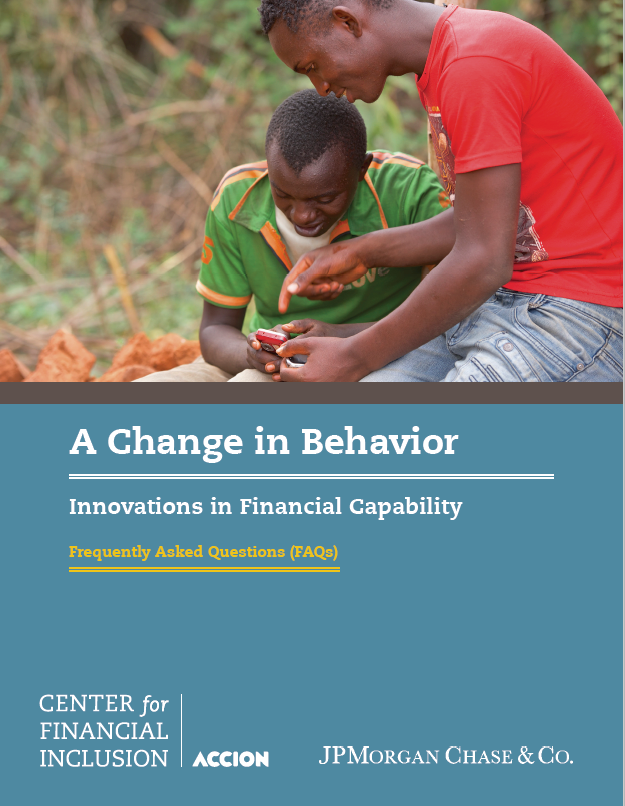A Change in Behavior: Innovations in Financial Capability
This report--funded by JPMorgan Chase & Co and produced by the Center for Financial Inclusion--assesses the global landscape of financial capability innovations, with special focus on India and Mexico. Highlighting a trend in its early stages, it explores how organizations are tying financial capability interventions more closely to customer behavior, especially at critical decision-making moments, such as when signing up for and using financial products. Expansion of this approach, which is growing, will require creative ideas beyond the traditional financial education that still dominates the scene, and greater involvement by providers, who are uniquely placed to meet clients at critical decision moments.
Financial Capability: the combination of knowledge, skills, attitudes, and behaviors a person needs to make sound financial decisions that support well-being.
(Click the cover images to view or download the full document.)
The financial capability approach takes knowledge transfer out of a classroom and pairs it with well-designed products. Behavioral economists argue that human biases often inhibit our ability to make good decisions. They point to the important gap between knowing and doing. People tend to value the present over the future; need frequent reminders to apply what they have learned or resolved; and follow habitual routines to navigate day-to-day life. These biases can shape financial behavior, often resulting in the failure to act despite knowledge. In addition, attitudes and practices learned from parents and peers strongly shape a customer’s financial habits.
These insights point to the need to design capability interventions that address the knowing-doing gap and take psychological and cultural factors into account. We advocate the application of behaviorally informed practices that have the potential to make financial capability interventions more effective. We are pleased to see an arsenal of tools emerging that employ them. Briefly, these practices are:
The Seven Behaviorally-Informed Practices for Effective Financial Capability Interventions
- Teachable Moments. Reach consumers when they are making financial decisions.
- Learning by Doing. Let consumers practice using products.
- Nudges, Reminders, and Default Options. Timely reminders and default options support good habits.
- Rules of Thumb (Heuristics). Mental short cuts help turn learning into habit.
- Make It Fun. Games and humor aid learning and retention.
- Customize It. Tailor advice to an individual’s specific financial situation.
- Make it Social. Leverage the influence of peers and culture.
We advocate six major recommendations in how stakeholders in financial inclusion approach financial capability, recognizing that each recommendation will require an enormous amount of dedication and effort on the part of many players.
Six Recommendations for Effective Financial Capability
- Bring financial capability efforts closer to the actual use of financial services by enabling providers to take a greater role.
- Strengthen the government’s focus on promoting shared responsibility among all stakeholders, in addition to its own role.
- Engage organizations serving BoP constituencies, from government social service agencies to employers to non-profits.
- Incorporate proven elements that support behavior change into existing financial education and financial capacity efforts.
- Measure results rigorously.
- Foster customer-led financial capability.
These efforts require the combined efforts of many stakeholders. To make a shift of this magnitude, we need to leverage all the tools, including technological innovations, peer networks, behaviorally informed strategies, and product design approaches that place the customer at the center. There are still many unanswered questions such as how to build a sustainable business case or the true impact of many of these interventions. However, we see some easy targets for providers to quickly incorporate, from reminder messages, to opportunities for clients to practice using a service with a staff person, to building up the financial capability of staff.
We urge providers to learn from their customers and find ways to pair products and information to help clients establish behaviors to meet their goals. Financially capable people, particularly those with low, irregular incomes, have to fight a lot of battles to maintain financial discipline. The least we could do is to work together with all stakeholders to develop products, policies, and strategies to make it easier to be financially capable.
Download the Executive Summary »









